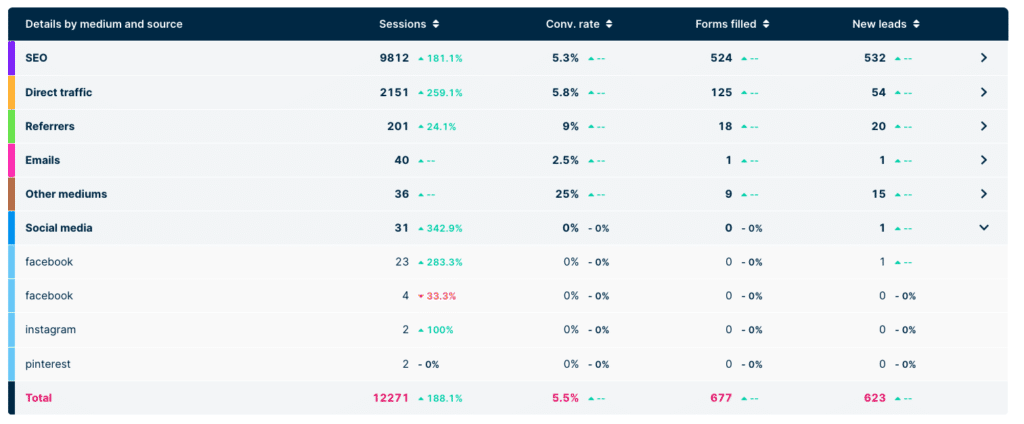People used to say that all roads led to Rome. Now, all marketing channels lead to your website, including advertising, organic search, and social media. But there’s also another channel that is both highly effective and still not well understood by a lot of marketers: direct traffic.
An increase in your direct traffic might represent increased brand awareness and word of mouth recommendations. But because it actually groups together a number of different traffic sources, it can be difficult to know just exactly what it measures.
So, how can you effectively track direct traffic to your website and interpret this data correctly? We’ll tell you everything you need to know in the post below.
What is direct traffic to your website?
Direct traffic is one of the main sources of traffic recorded in analytics tools like Google Analytics, along with search traffic, paid traffic, and social media traffic. In theory at least, direct traffic refers to visitors that have come to your website by typing its URL address directly into their browser.
In practice however, visits can be categorized as direct traffic for a number of different reasons. Google Analytics will report a visit as being direct traffic any time that it can’t identify how that visit arrived at your website.
This includes:
- Visitors who type your website’s URL address directly into their browser
- Visitors who have bookmarked your website and who click on this to get there
- Visitors who click on a link in a non-web document (e.g., a PDF or Word document) or who come from links in software or a mobile app
- Visitors from another website that click on a link that contains a “rel=norefferer” tag
- Visitors who have not agreed to the use of cookies on your website
- Visitors who use private browsing to visit your website
- Visitors arrive at a page on your website from a 302 temporary redirect
- Visitors from “dark social” sources (e.g., email, WhatsApp, mobile phone texts, Facebook Messenger)
As you can see, direct traffic is actually a catch-all traffic source that includes everything that tools like Google Analytics don’t have any data for.
How to track direct traffic to your website
Although direct traffic can actually come from a number of different sources, it’s easy to start analysing it. You can use an analytics tool like Google Analytics, or Plezi One, our free tool that will help you turn visitors to your website into leads.
Using Google Analytics
- Log in to your Google Analytics account.
- In the left menu, click on the Acquisition tab
- Under “All Traffic”, click on Channels
- Here you will see traffic broken down by different channels, including direct traffic, over the period indicated.
Using Plezi One
- Log in to your Plezi One account or create one for free here.
- In the Dashboard, you will find the report “Website’s performance by digital channel”
- This report will show you all sources of traffic to your website, including direct traffic. It will also show you how traffic sources have changed compared to the previous period, enabling you to easily evaluate your progress.

How to interpret direct traffic
Increased visitor loyalty
Increased direct traffic to your website can be a good sign. It can represent visitors who value your website and who return to it often. They can do this by typing your website address into their browser or, even better, by clicking on their bookmarks to go to a blog post or product pages that interest them.
Increased brand awareness
Direct traffic can also represent word of mouth recommendations for your business, including visitors that come as a result of conversations between friends or colleagues.
These can also come from professional networks. There are a large number of Whatsapp, Slack, or Discord groups that bring together people from the same profession and who might share your product pages or blog content.
So, an increase in direct traffic can be read as an increase in loyalty and brand awareness.
Effective offline marketing
Running an offline advertising campaign for radio, TV, or print, or distributing promotional material at a business event can also result in increased direct traffic. This is especially true if you have included your website address in your advertising.
The problem with direct traffic
The main problem with direct traffic is that its catch-all nature as a category can make the data less reliable. Because direct traffic can include visitors that come from a range of different channels (e.g., arriving directly on your website, from a PDF document, “dark social”), you need to take a bit of care when interpreting it.
So, if you want to better understand where your direct traffic comes from, and therefore where leads come from, you need to be able to correctly attribute the sources of this traffic.
How to correctly attribute direct traffic
Being able to identify the exact sources of your direct traffic and understanding those that produce better conversion rates is key to making decisions for your marketing strategy.
Here’s how to better attribute the sources of direct traffic to your website.
Avoid using 302 redirects
Firstly, check if any of the links to different pages on your website use redirects. If they do, these redirects should be permanent ones (a 301 redirect) and not temporary (a 302 redirect).
You can use the free SEOMinion browser extension for Chrome or Firefox to check whether any links to or on your website include a redirect.
Add UTM tags to your campaigns
There is one sure-fire way to let you see where direct traffic to your website comes from: UTM parameters.
These are tags inserted at the end of URLs that let you track the sources of traffic to your website.
To be able to use these effectively, you need to know something about the 3 main UTM parameters.
UTM Medium
The “utm_medium” tag tracks the channel that traffic comes from. The specific tag used will depend on the channel on which a URL link to your website will appear.
For example:
- social: for social media
- email: for email marketing campaigns
- cpc: for paid advertising campaigns
- referral: for links included on the websites of companies you partner with
- affiliate: for affiliate marketing campaigns
- document: for links included in non-web documents
UTM Source
The “utm_source” tag is used to track the ultimate source of traffic to your website. For example, it lets you identify whether social media traffic came from Facebook, LinkedIn, or YouTube. Or it can let you identify whether traffic from an email marketing campaign came from a newsletter, product email, or welcome email.
UTM Campaign
The “utm_campaign” tag is used to designate the marketing campaign or action in the context of which a link was shared. For example, this could be the name of an advertising campaign or the name of the PDF document in which the link is shared.
Use UTM tags everywhere (yes, everywhere!)
Using these UTM parameters will let you correctly attribute the sources of direct traffic to your website. For example, they’re a great way to analyse the sources of website traffic generated by the links included in your premium content.
All links in non-web content (e.g., white papers, templates, or operational kits), should include UTM tags, with the utm_medium tag marked as a document.
The same goes for email marketing campaigns, with the name of the campaign specified in the utm_campaign tag.
If you carry out a lot of offline marketing, you can also use UTM tags in your marketing materials, for example in a QR Code or in a shortened link. This will enable offline visitors to still access your website easily and ensure that you can identify the sources of this traffic.
Using UTM parameters will let your web analytics tool attribute direct traffic to the correct source. It will also let you better measure the performance of your different marketing channels.
To help you generate URLS that include UTM tags, we’ve created a free UTM link generator for you to download.
It’s important to be able to understand where direct traffic to your website actually comes from. An increase in direct traffic can be a good sign, provided that you use UTM parameters to track the different channels that this traffic comes from. Direct traffic also typically comes to your website as a result of your other SEO or advertising strategies. If you want to see this figure increase, you’ll first need to have a strong traffic acquisition strategy in place to do so.







